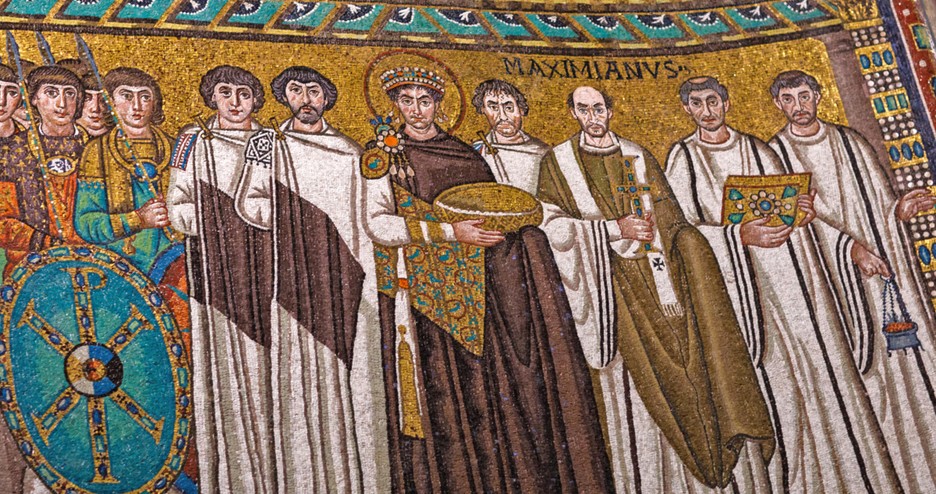
Have you ever noticed that the Bible gives us no clue as to what Jesus looked like? All our paintings of Jesus are merely the artist's idea of how he might have looked. The first representation of Christ on record is actually a derisive graffiti on the wall of a house on Palatine Hill in Rome. It pictured the body of a man being crucified but with the head of an ass. The inscription reads: "Alexamenos worships his god."
The Early Christian Church
From the time of Nero (64 A.D.) until the conversion of Emperor Constantine and the Edict of Milan (313 A.D.), whereby Christianity was made legal, the Christian faith was officially regarded as a religio prava, an evil or depraved religion.
Christianity's Jewish Roots
Christianity began as a movement within Judaism. Much of the earliest proclamation of the Gospel took place in the synagogues. The Christians did not side with the Jews in their revolt against Rome beginning in 66 A.D., and by the end of the first century, the church had largely separated from the synagogue.
When a "Church" wasn't a building
These early believers did not have church buildings to meet in. They met mostly in homes. The first church buildings did not start to appear until the early 200s.
Debate but not Denominations
The early church did not have denominations as we think of them today. But that does not mean they had no serious disagreements within the ranks. They did. And they did not find this surprising. They felt they were dealing with matters of ultimate truth and error - matters to be taken with the utmost seriousness even when it meant dissension.
Torn by dogs, nailed to crosses...
The early Christians were the targets of repeated persecutions - some of unspeakable cruelty. For example, the emperor Nero blamed the Christians for the great fire that destroyed 10 of the 14 city wards at Rome in 64 A.D., a fire that Nero apparently had ordered himself. The historian Tacitus, not a Christian, said that Nero had the believers "torn by dogs, nailed to crosses, . . . even used as human torches to illumine his gardens at night."
But Christians were not under persecution everywhere and all the time. The persecutions were sporadic, with peaceful intervals in between. They varied in their intensity and were mostly localized.
Just Get your Certificate!
There were two all-out empire-wide persecutions intended to utterly destroy the church. The first, under the emperor Decius, began in December 249. Everyone in the empire had to get a certificate from a government officer verifying that he or she had offered a sacrifice to the gods - an act that most Christians in good conscience could not do.
The second, called "The Great Persecution," began on February 23, 303, under Emperor Diocletian. Galerius, the empire's second-in-command, was behind this persecution policy and continued it after Diocletian's death. For eight long years, official decrees ordered Christians out of public office, scriptures confiscated, church buildings destroyed, leaders arrested, and pagan sacrifices required. All the reliable methods of torture were mercilessly employed - wild beasts, burning, stabbing, crucifixion, the rack. But they were all to no avail. The penetration of the faith across the empire was so pervasive that the church could not be intimidated nor destroyed. In 311, the same Galerius, shortly before his death, weak and diseased, issued an "edict of toleration." This included the statement that it was the duty of Christians "to pray to their god for our good estate."
Christian Baptism
The Christian writer Hippolytus, writing about 200 A.D., describes baptism in Rome. Candidates took off their clothing, were baptized three times after renouncing Satan and affirming the basic teachings of the faith, and put on new clothes. Then they joined the rest of the church in the Lord's Supper.
Baptism was not entered into lightly. First, one went through an extensive period of preparation as a "catechumen." This lasted as long as three years, involving close scrutiny of the catechumen's behavior. The church would only admit those who proved to be sincere in seeking a totally new life within the Christian community.
Slave makes good!
Christians drew members into their fellowship from every rank and race, an affront to proper, class-conscious Romans. A former slave who had worked the mines actually became the bishop of Rome -- Callistus in 217.
"Send me your letters and gifts"
Misusing the Gospel for financial gain is by no means the invention of 20th-century religious hucksters. One of the earliest Christian documents after the New Testament, The Didache, a kind of manual on church practice, warns about traveling preachers who come and ask for money. The satirist Lucian in the second century, ridiculed Christians for being so easily taken in by charlatans, often giving them money. Lucian recorded the notorious case of the philosopher Peregrinus, who attracted a devoted following among Christians (and a lot of money)before he was found out. The showman instincts of Peregrinus reached their climax when he died by publicly cremating himself at the close of the Olympic games in 165.
Three-fourths non-white
Researcher David Barrett reports that by the year 300, or nine generations after Christ, the world was 10.4% Christian with 66.4% of believers Non-whites. The scriptures had been translated into ten languages. More than 410,000, representing one in every 200 believers from the time of Christ, had given their lives as martyrs for the faith.
("A Look at the Early Church" by Ken Curtis published on Christianity.com on April 28, 2010)
How Was the Early Church Perceived?
The 1st Century Church lived their irresistible Christian lives walking in the Spirit. Those early Christians faced the hostile world, walking in the power of the Holy Spirit. If we were to read the newspapers of the day through secular historical writers alive in the 1st Century here is what we would find.
When Pliny was governor of Bithynia, he wrote a most interesting letter to the Roman Emperor Trajan, asking why Christians were being exterminated, and added:
"I have been trying to get all the information I could regarding them. I have even hired spies to profess to be Christians and become baptized in order that they might get into the Christian services without suspicion.
"Contrary to what I had supposed, I find that the Christians meet at dead of night or at early morn, that they sing a hymn to Christ as God, that they read from their own sacred writings and partake of a very simple meal consisting of bread and wine and water (the water added to the wine to dilute it in order that there might be enough for all).
"This is all that I can find out, except that they exhort each other to be subject to the government and to pray for all men."
Writing in about AD 125 Aristedes a Christian philosopher looked at the believers of his day and said:
"They walk in all humility and kindness, and falsehood is not found among them, and they love one another. They despise not the widow, and grieve not the orphan. He that hath distributeth liberally to him that hath not. If they see a stranger they bring him under their roof, and rejoice over him, as it were their own brother: for they call themselves brethren, not after the flesh, but after the Spirit and in God; but when one of their poor passes away from the world, and any of them see him, then he provides for his burial according to his ability; and if they hear that any of their number is imprisoned or oppressed for the name of their Messiah, all of them provide for his needs, and if it is possible he may be delivered, they deliver him. And if there is a man among them that is poor and needy, and they have not among them an abundance of necessaries, they fast two or three days that they may supply the needy with their necessary food."
Taken from "Irresistible Love" by Discover the Book Ministries (used by permission).


